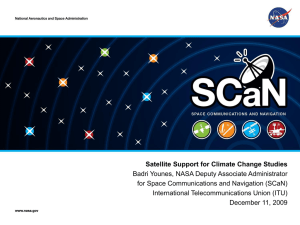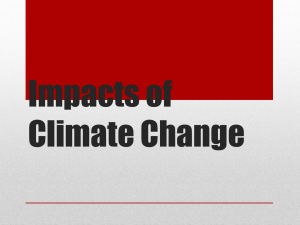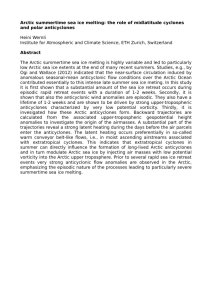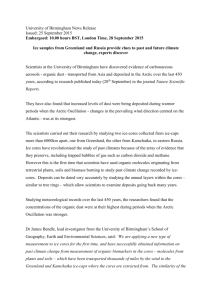Dr. Graeme Stephens
advertisement
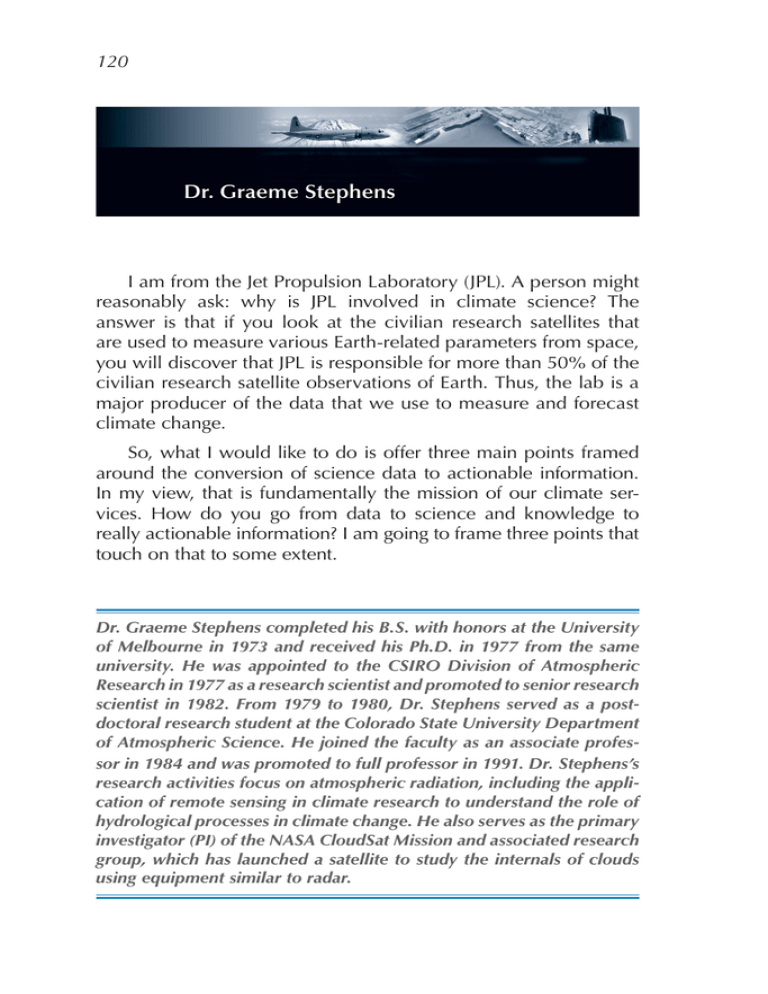
120 Dr. Graeme Stephens I am from the Jet Propulsion Laboratory (JPL). A person might reasonably ask: why is JPL involved in climate science? The answer is that if you look at the civilian research satellites that are used to measure various Earth-related parameters from space, you will discover that JPL is responsible for more than 50% of the civilian research satellite observations of Earth. Thus, the lab is a major producer of the data that we use to measure and forecast climate change. So, what I would like to do is offer three main points framed around the conversion of science data to actionable information. In my view, that is fundamentally the mission of our climate services. How do you go from data to science and knowledge to really actionable information? I am going to frame three points that touch on that to some extent. Dr. Graeme Stephens completed his B.S. with honors at the University of Melbourne in 1973 and received his Ph.D. in 1977 from the same university. He was appointed to the CSIRO Division of Atmospheric Research in 1977 as a research scientist and promoted to senior research scientist in 1982. From 1979 to 1980, Dr. Stephens served as a postdoctoral research student at the Colorado State University Department of Atmospheric Science. He joined the faculty as an associate professor in 1984 and was promoted to full professor in 1991. Dr. Stephens’s research activities focus on atmospheric radiation, including the application of remote sensing in climate research to understand the role of hydrological processes in climate change. He also serves as the primary investigator (PI) of the NASA CloudSat Mission and associated research group, which has launched a satellite to study the internals of clouds using equipment similar to radar. Chapter 4 Adapting Research to Climate Challenges 121 First, I think it is pretty important to find what data we need and what specific requirements we would place on those data. To do that, we have to ask the question of what the heck is your mission and what do you actually wish to achieve. Second, we currently have a variety of data collection resources that already exist and could be used to help address this problem. We need to ensure that we optimally exploit those resources. I am going to throw out two examples of many that could be identified. Then I am going to make the point that climate observations are not the same as weather observations. It is just not a matter of making them over a long period of time. There are different sets of observations that are needed really to understand and to predict the climate change. There are all sorts of measurements that are not high on the operational radar screen but are absolutely critical for climate. The third point I want to make is that the DoD needs to be an important stakeholder in defining climate data needs, particularly from the point of view of Earth observations. As I said, the Earthobserving community relies almost exclusively on downwardlooking satellites to measure the Earth’s system; they are absolutely critical for the Arctic. So let us begin by talking about defining the data requirements. Clearly, we have to define what our highest-priority challenges are. Based on my attendance here the last 2 days, I have figured out that we have begun to articulate this, but it is not yet sharply articulated. We have talked about sea-level rise, storm surges, Arctic navigability, and so on, but we have not identified either the specific data that we need or the specific reason that we need it. We really need to sharpen this. For example, what time horizon do we want data for? Clearly we want to predict into the future that is being talked about. Is it a week? Is it a season? Is it a year? Is it decadal? Is it multidecadal? As I indicated previously, many of the essential climate observations are derived from current civilian research satellites that are not part of the operational weather forecasting system. Many of those satellites may not even be ready to be part of an operational 122 Climate and Energy Proceedings 2011 system. They may be too expensive to be part of an operational system. So, to recap, point number one is define the requirements, the time horizon, the spatial scale, and the latency. These factors will influence how we produce the data and whether the data that we have streaming down now are actually relevant to our mission objectives. Now let us look at two examples of many that exploit existing resources. Our climate projections rely on the observational data records that we have, and that is an activity that is going on now, but that is an example of something we could do with existing resources. I will start with sea-ice change, because it appears that sea-ice change is a big deal for this audience. We learned a number of important lessons from the precipitous loss of sea ice that occurred in 2007. That year’s dramatic loss was off the record book. As a result, we learned that sea ice is vulnerable to climate effects but is relatively invulnerable to other forces. However, it is the other forces that fundamentally will shape whether the sea ice opens up or closes in the summer. It is those other forces that have to do with meteorology weather pattern changes. One of the big factors in 2007 that does not get discussed much is that the atmosphere dried out; the cloud disappeared. There was perpetual sunshine for 3 months. The warmer sea surface temperatures (SSTs) further exacerbated the loss of sea ice and so on. Obtaining information on that kind of energy coming into the Arctic Ocean is pretty important for a prediction of sea ice and seasonal swings in sea ice. We currently do not have the observing systems necessary to address that today, so that is the sort of information that we need in order to understand sea-ice loss. In terms of research satellites, we have unprecedented information from research satellites that I think are ready to be exploited to look at some of these issues with sea ice. It is data coming in that is untapped from the point of view of studying the Arctic. The Arctic’s really interesting, including from the polar satellite point of view. Because all longitudes converge at the pole, all of the polar orbiting satellites will also converge to the pole. That is why you can get 16 synthetic aperture radar (SAR) samples from one satellite in a day. So, you get a lot of data covering the poles. Chapter 4 Adapting Research to Climate Challenges 123 The question is: is it the right kind of data for what you have in mind? With the new research observations that we have today, we have unprecedented views of the Arctic that we have never had before. It is a gold mine waiting to be tapped. We are just not tapping it as a research community because we are not challenged to do so. We are doing all sorts of other things. One of our lowhanging fruits is to make use of the capabilities we have today to explore issues related to the loss of sea ice. Another aspect of sea-level rise is that it hits a bit close to home for the Jet Propulsion Laboratory. Sea-level rise is a pretty complex problem. It involves the changing of the thermal structure of the oceans. It involves ice sheet dynamics and its changes, and it involves solid earth responses. As a result, predicting future sealevel rise is complicated but, given our ability to make observations, it turns out that the sea-level rise problem is in better shape than most other areas of the climate problem. We have systematic observations of sea-level rise. We have incredibly new ways of observing ice-mass loss that we see. We have seen the acceleration of the Greenland Ice Sheet over the last decade from space. However, we currently have no modeling and assimilation tools that describe sea-level rise, so we have a building block program to develop a system that would provide actionable information. We have the wherewithal and we have the interest to do this, so we have a consortium community involved—a number of universities, the JPL, and other communities that are heavily engaged in the sea-level problem, observing sea level, and modeling sea level have put their hands up. They are interested in taking the next step to identify and work with users and determine what the product ought to be and on what scale the products ought to be. My third and last point concerns establishing the DoD as an important stakeholder within the community of civilian observing systems. The DoD has already established stakeholder positions in other aspects of the modeling, but I think the civilian program needs help with their civilian satellite observing systems and would certainly benefit from the DoD’s stakeholder involvement. To further illustrate this point, consider the European Centre for Medium-Range Weather Forecasts (ECMWF), which is one of the 124 Climate and Energy Proceedings 2011 major weather forecasting centers on our planet. The ECMWF produces weather analysis that gets integrated into the climate record through a process called reanalysis. That process combines over 30,000 surface observations every 3 hours to create a climate record. However, if you disregard the data from the Scandinavian countries, you could count almost on one hand the number of actual surface observations from above the Arctic Circle that go into this reanalysis product. For such data-sparse regions, reanalysis relies on model-based inputs rather than observation-based inputs. Is that good or bad? Well, we do not know, but we know that in key areas the models are particularly bad. Those key areas include ones that relate to energy flow into the Arctic, which is very important for sea-ice loss. We also know that the models are fairly poor at predicting clouds and precipitation, both of which are pretty important for the Arctic climate. As we have heard, we do not really have a climate record for the Arctic. One of the reasons is that the Arctic is very sparsely observed. This is why satellites are so critically important. They can provide the density of observations that you just cannot produce with surface stations, especially given the harsh environment. Satellites have to play an important role. In the case of climate, as I emphasized, many of our key measurements come from civilian research satellites. These measurement systems are fragile. They are fragile because they are primarily tied to discretionary funding lines and are not linked to observations. As a result, they basically come and go depending on budgets, and we have just had two major flagship climate satellites cancelled in the last couple of months. So the situation is fragile. What is of even greater concern is that we do not have a strategy to observe key parts of the climate system from space. We do not have a coherent plan for measuring precipitation globally. Currently, it is all done using research satellites rather than operational ones. We are not measuring snowfall in the Arctic, which is a key part of the water cycle of that region. So, given the fragility of the civilian part of our observing systems, having key stakeholders articulate their needs will strengthen the argument for moving from research systems to operational systems.

